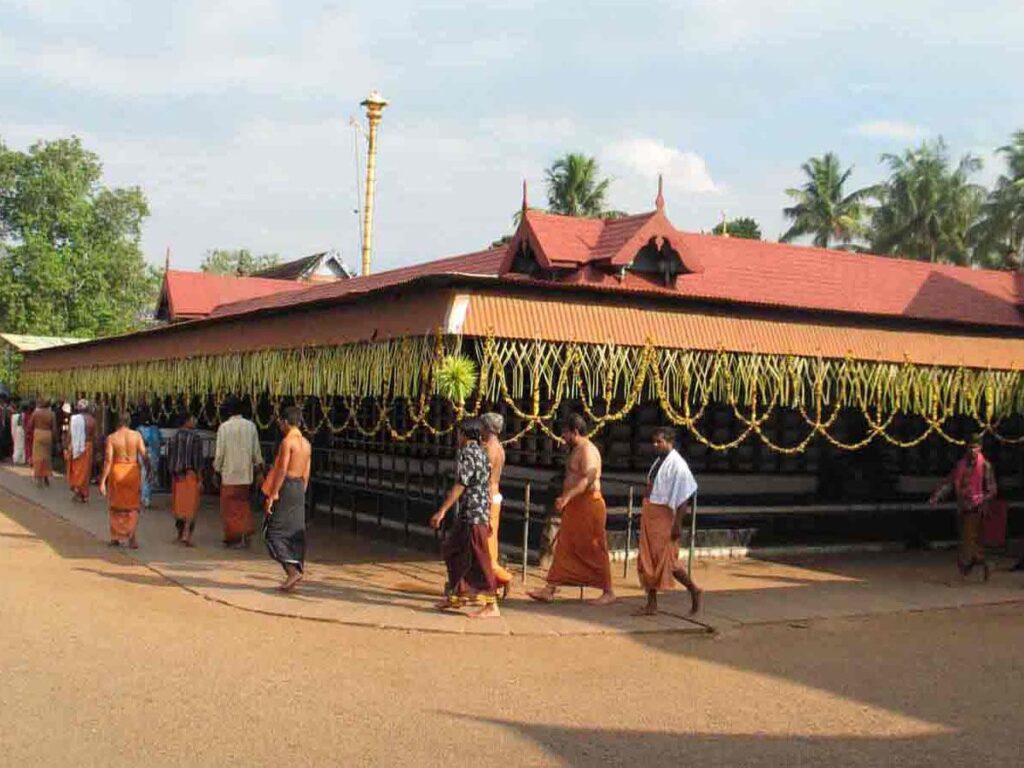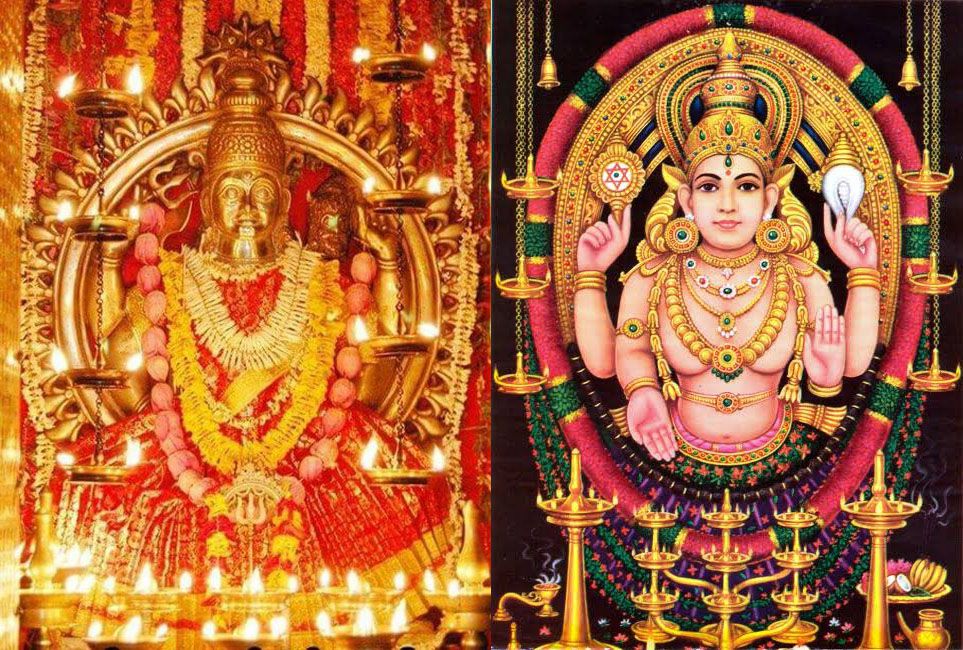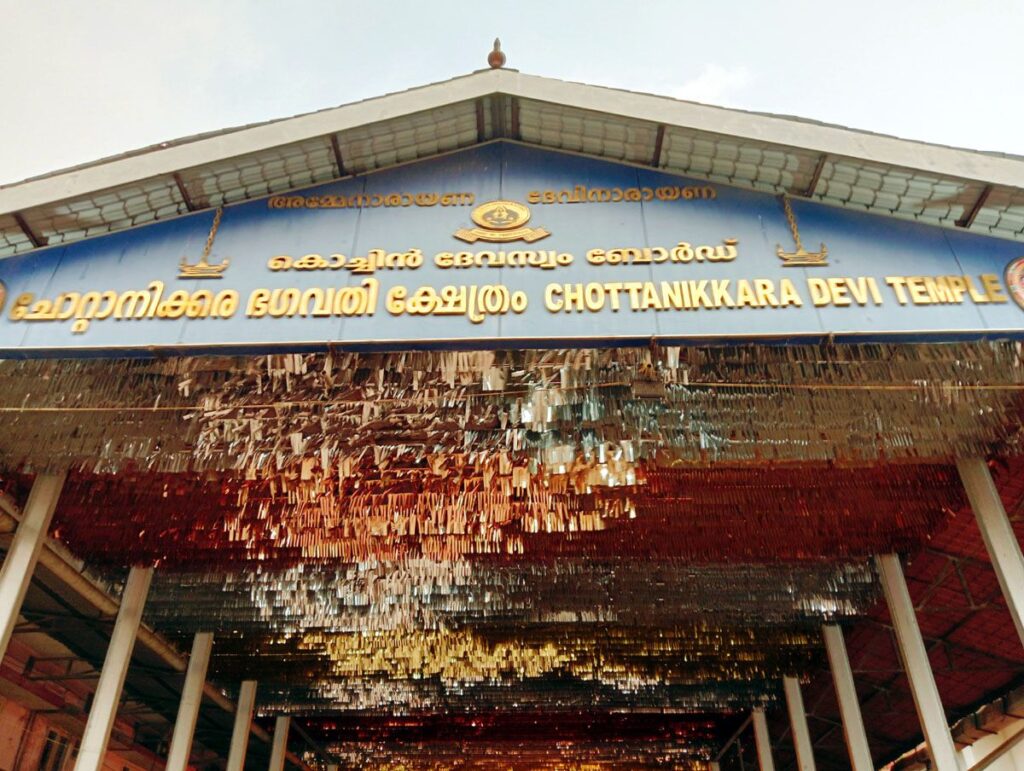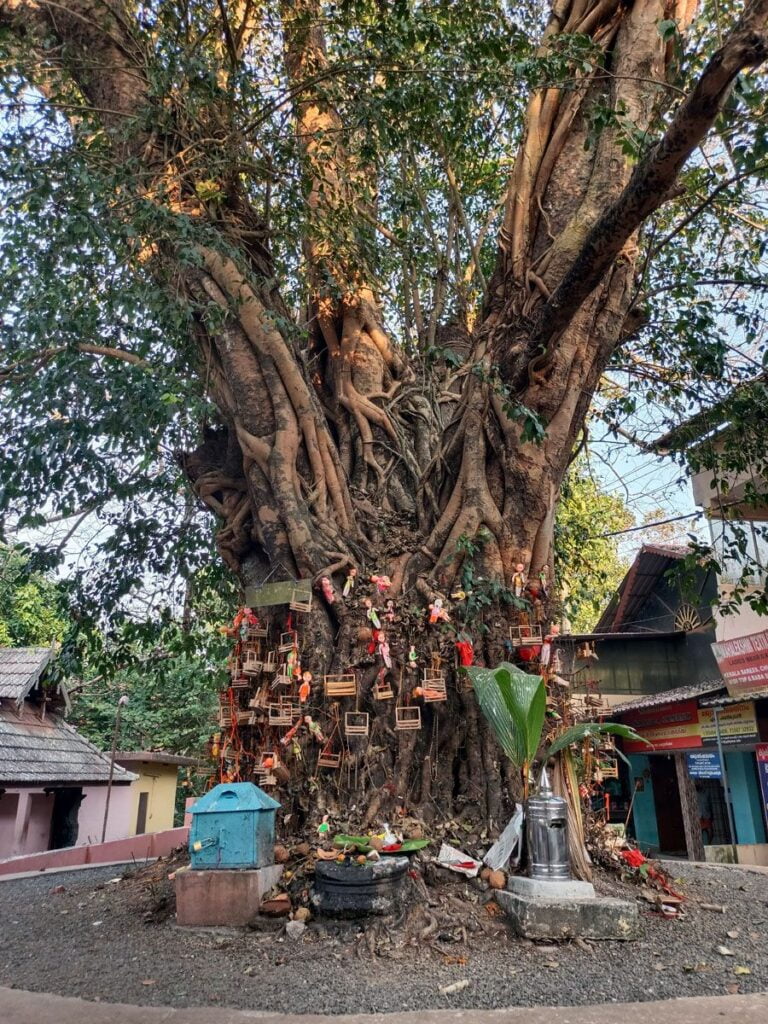Chottanikkara Temple Ernakulam Kerala
The Chottanikkara Temple is a Hindu temple dedicated to the goddess Bhagavathy, located in the Chottanikkara village of Ernakulam district, Kerala, India. The temple is one of the most popular pilgrimage sites in Kerala, and is known for its unique architecture and the legend of Kannappan.

Contents
- 1 Chottanikkara Temple History:
- 2 Legend of Chottanikkara Temple:
- 3 Significance of Chottanikkara Temple:
- 4 Myths of Chottanikkara Temple:
- 5 Chottanikkara Temple Ghost:
- 6 Chottanikkara Temple Timing and Rituals:
- 7 Places to visit near Chottanikkara Temple:
- 8 FAQ:
- 9 How to reach Chottanikkara Temple:
- 10 Google Maps:
Chottanikkara Temple History:
The history of the Chottanikkara Temple is shrouded in mystery and legend. According to one legend, the temple was built by the sage Parasurama, who is said to have installed the idol of Bhagavathy here. Another legend states that the temple was built by the Chera king Sthanu Ravi Varma.
The temple is believed to have been renovated and expanded several times over the centuries. The earliest known renovation was carried out by the Travancore king Marthanda Varma in the 18th century. The temple was further renovated and expanded in the 19th century by the Travancore queen Umayamma Rani.
The Chottanikkara Temple is a complex of several shrines, the most important of which is the sanctum sanctorum, which houses the idol of Bhagavathy. The idol is made of laterite and is in the form of a lingam. The sanctum sanctorum is surrounded by a number of smaller shrines, dedicated to various deities, including Shiva, Vishnu, and Ganesha.
The temple is also home to a number of sacred trees, including the banyan tree, the peepal tree, and the tulsi plant. The banyan tree is considered to be particularly sacred and is said to be the abode of the goddess Bhagavathy.
The Chottanikkara Temple is a major pilgrimage center and attracts thousands of devotees from all over India. The temple is particularly popular during the festival of Navratri, which is celebrated in the month of September or October.
Here are some of the important events in the history of the Chottanikkara Temple:
- 8th century: The temple is believed to have been built by the sage Parasurama.
- 18th century: The temple is renovated and expanded by the Travancore king Marthanda Varma.
- 19th century: The temple is further renovated and expanded by the Travancore queen Umayamma Rani.
- 1950s: The temple is declared a national monument by the Government of India.
- 2000s: The temple undergoes a major renovation and restoration project.

Legend of Chottanikkara Temple:
The legend of the Chottanikkara Temple tells the story of a young girl named Kannaki. Kannaki was the daughter of a wealthy merchant and was known for her beauty and devotion to the goddess Bhagavathy. One day, Kannaki was walking through the forest when she came across a group of men who were about to sacrifice a calf to the goddess. Kannaki was horrified by this and begged the men to spare the calf’s life. The men refused and Kannaki, in her anger, cursed them. The men were immediately turned to stone.
Kannaki then took the calf to her home and raised it as her own. The calf grew into a beautiful cow and Kannaki would often take it to the forest to graze. One day, while Kannaki was in the forest, a group of bandits attacked her and stole her cow. Kannaki was devastated and prayed to the goddess Bhagavathy for help. The goddess appeared to Kannaki and told her that she would help her find her cow.
The goddess led Kannaki to a cave in the forest where the cow was being held captive. Kannaki was overjoyed to see her cow again and thanked the goddess for her help. The goddess then told Kannaki that she would build a temple in her honor at the spot where the cow had been found.
The Chottanikkara Bhagavathy Temple was built on the spot where the cow had been found and is still standing today. The temple is a popular pilgrimage site and is known for its unique architecture. The temple is built in the traditional Kerala style and has a three-tiered gopuram (gateway tower). The main deity of the temple is the goddess Bhagavathy, who is depicted in a seated position. The goddess is flanked by the deities Shiva and Vishnu.
The Chottanikkara Bhagavathy Temple is a popular pilgrimage site and is known for its unique architecture and the legend associated with it. The temple is a must-visit for anyone interested in Hindu mythology and culture.
Here are some additional details about the legend of the Chottanikkara Temple:
- The name “Chottanikkara” is believed to be derived from the words “chottan” (calf) and “kara” (place).
- The temple is also known as the “Sree Chottanikkara Bhagavathy Temple” and the “Chottanikkara Devi Temple”.
- The main deity of the temple is the goddess Bhagavathy, who is also known as Rajarajeswari, Adiparasakthi, and Bhadrakali.
- The goddess is worshipped in three forms: Saraswati in the morning, Lakshmi at noon, and Durga in the evening.
- The temple is one of the 108 Divya Desams, or holy shrines of Vaishnavism.
- The temple is also known for its exorcism rituals.

Significance of Chottanikkara Temple:
- Religious significance: The temple is dedicated to the Hindu mother goddess Bhagavati, who is one of the most important deities in Hinduism. She is worshipped as the supreme goddess, the source of all creation, and the protector of the universe.
- Historical significance: The temple has a long and rich history that dates back to the 8th century AD. It is believed that the temple was built by the Chera king Kulasekhara Perumal.
- Architectural significance: The temple is a beautiful example of Kerala architecture. The temple complex consists of several shrines, including the main shrine of Bhagavati, the shrine of Lord Vishnu, and the shrine of Lord Shiva.
- Cultural significance: The temple is an important cultural center in Kerala. It is a place where people from all walks of life come together to worship the goddess and to seek her blessings.
Myths of Chottanikkara Temple:
There are many myths and legends associated with the Chottanikkara Temple. One of the most popular myths is the story of Kannappan, a tribal hunter who was a devotee of the goddess Bhagavathy. One day, Kannappan found a calf in the forest and brought it home to sacrifice to the goddess. However, his daughter Pavizham pleaded with him not to kill the calf, and Kannappan agreed. The next day, Pavizham was found dead, and Kannappan was grief-stricken. He took the calf to the temple and offered it to the goddess, asking her to forgive him for his daughter’s death. The goddess was pleased with Kannappan’s devotion, and she brought Pavizham back to life.
Another myth associated with the Chottanikkara Temple is the story of Adi Shankaracharya, a Hindu philosopher and saint. Adi Shankaracharya is said to have visited the temple and installed the idol of the goddess Bhagavathy. He also established a school of Vedic studies at the temple.
The Chottanikkara Temple is also associated with the legend of the demon Darika. Darika was a powerful demon who was granted a boon by Brahma that she could not be killed by any man or god. Darika began to terrorize the world, and the gods were unable to defeat her. Finally, the goddess Bhagavathy took the form of a young woman and challenged Darika to a duel. Darika was killed by the goddess, and the world was saved.

Chottanikkara Temple Ghost:
The legend behind the temple’s association with ghosts and spirits dates back to the 17th century. It is said that a Brahmin named Gupthan Namboodiri was once possessed by an evil spirit while on a visit to the temple. The spirit, in the form of a beautiful woman, tried to seduce Gupthan, but he was able to resist her advances by reciting the Devi Mahatmyam, a sacred Hindu text. The spirit was then forced to leave Gupthan’s body and take refuge in a nearby tree.
Since then, the Chottanikkara Temple has become a popular destination for people seeking to be cured of demonic possession and other spiritual afflictions. The temple’s exorcism rituals are performed by a team of priests, who chant mantras and offer prayers to the goddess Bhadrakali. The rituals are often long and arduous, and can involve the use of various physical and psychological techniques to drive out the evil spirit.
While there is no scientific evidence to support the existence of ghosts or spirits, the Chottanikkara Temple continues to attract thousands of visitors each year. For many people, the temple is a place of hope and healing, and a source of comfort and strength in the face of adversity.
Chottanikkara Temple Timing and Rituals:
The temple is open from 4:00 AM to 8:45 PM. The following are the timings of the various rituals performed at the temple:
- Nirmalya Darshan: 4:00 AM (3:30 AM on Fridays and during Mandalam season)
- Dhara of Lord Shiva: 5:00 AM and 10:45 AM
- Ethruthu Pooja: 5:30 AM
- Seeveli: 5:45 AM and 12:00 PM
- Guruthi Nivedyam at Kizhukavu Temple: 7:30 AM and 7:00 PM
- Pantheeradi Pooja: 7:00 AM to 8:00 AM
- Ucha Pooja: 11:00 AM to 11:30 PM
- Deeparadhana: After 6:00 PM (based on sunset)
- Athazha Pooja: 7:00 PM
- Valiya Guruthi at Kizhukavu Temple: After 8:30 PM
The following are some of the important rituals performed at the Chottanikkara Bhagavathy Temple:
- Guruthi: This is a special ritual performed at the temple to ward off evil spirits and negative energies. It is performed by offering a mixture of lime and turmeric to the goddess.
- Pushpanjali: This is a ritual of offering flowers to the goddess.
- Arathi: This is a ritual of waving a lighted lamp in front of the goddess.
- Annadanam: This is a ritual of feeding the poor.

Places to visit near Chottanikkara Temple:
- Kochi (Cochin): Explore the vibrant city of Kochi, known for its historical landmarks, such as Fort Kochi, Mattancherry Palace, and the Chinese Fishing Nets. The city also has a rich cultural heritage with art galleries, museums, and traditional Kathakali performances.
- Hill Palace Museum: Located in Tripunithura, the Hill Palace Museum is the largest archaeological museum in Kerala. It houses a vast collection of artifacts, antiques, and exhibits showcasing the royal heritage of the region.
- Marine Drive: Enjoy a leisurely walk along Marine Drive in Kochi, which offers picturesque views of the backwaters and the city skyline. The area is dotted with shops, cafes, and parks.
- Bolgatty Palace: Visit Bolgatty Palace, situated on the Bolgatty Island in Kochi. The palace, surrounded by lush greenery, offers a tranquil environment. You can also explore the nearby Bolgatty Island Resort.
- Wonderla Kochi: If you’re looking for some fun and excitement, consider visiting Wonderla, an amusement park located near Kochi. It features thrilling rides, water attractions, and entertainment for visitors of all ages.
- Vaikom Mahadeva Temple: Vaikom Mahadeva Temple, one of the oldest Shiva temples in Kerala, is located about 30 km from Chottanikkara. The temple has a unique architecture and is a significant pilgrimage site.
- Kodanad Elephant Training Centre: Located around 25 km from Chottanikkara, Kodanad is known for its elephant training center. You can observe and interact with elephants and learn about their conservation efforts.
- Kadamattom Church: Visit Kadamattom Church, an ancient Christian church known for its historical significance and architectural beauty. It is around 10 km from Chottanikkara.
- Idukki Dam: If you’re interested in nature and scenic landscapes, consider a trip to Idukki Dam. It’s a bit farther from Chottanikkara (about 100 km), but the journey is worth it for the breathtaking views of the Idukki Reservoir.
FAQ:
- Where is Chottanikkara Temple located?
- Chottanikkara Temple is situated in Chottanikkara, a suburb near Kochi in the state of Kerala, India.
- What deity is worshipped at Chottanikkara Temple?
- The main deity of Chottanikkara Temple is Goddess Bhagavathy, also known as Rajarajeswari or Adiparasakthi. The goddess is worshipped in three different forms – Saraswati in the morning, Lakshmi at noon, and Durga in the evening.
- What are the temple timings?
- The temple usually opens early in the morning and closes in the evening. However, specific timings may vary, so it’s advisable to check the current schedule before planning your visit.
- Are there any festivals celebrated at Chottanikkara Temple?
- Yes, the temple celebrates various festivals throughout the year. One of the most significant festivals is the annual Makam Thozhal, which usually takes place in the Malayalam month of Kumbham (February-March).
- Is there an entry fee to the temple?
- Temples in India generally do not have entry fees. However, there may be separate arrangements or fees for special darshan or rituals. It’s recommended to check with the temple authorities for the most accurate information.
- What are the important rituals performed at Chottanikkara Temple?
- The temple conducts regular poojas (rituals) dedicated to the goddess. Devotees often participate in special ceremonies and offerings to seek the blessings of the deity.
- Is there accommodation available near Chottanikkara Temple?
- There are usually hotels and guesthouses available in the vicinity of Chottanikkara Temple. It’s advisable to make accommodation arrangements in advance, especially during peak pilgrimage seasons or festivals.
- How can I reach Chottanikkara Temple?
- The temple is easily accessible by road from Kochi, which is well-connected by air, rail, and road. Local transport options like buses and taxis are available for reaching Chottanikkara Temple.
How to reach Chottanikkara Temple:
By Air:
The nearest airport to Chottanikkara is the Cochin International Airport (COK), which is approximately 29 kilometers away. From the airport, you can hire a taxi or use other transportation options to reach the temple.
By Train:
The nearest major railway station is Ernakulam Junction (South), which is about 17 kilometers away from Chottanikkara. From the railway station, you can hire a taxi or use other local transportation to reach the temple.
By Road:
- From Ernakulam (Kochi): Chottanikkara is well-connected by road from Ernakulam. You can hire a taxi, take a bus, or use your private vehicle to reach the temple.
- From Thrissur: If you are coming from Thrissur, you can take the NH544 and then switch to the SH21 towards Chottanikkara.
- From Kottayam: If you are coming from Kottayam, you can take the NH183 and then switch to the SH15 towards Chottanikkara.

One Comment